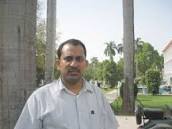Safdar Imam Quadri
 Sir Syed Ahmad Khan was perhaps the tallest among the people who propelled Indian renaissance in the nineteenth century. Like Gandhi, not only did he provide intellectual leadership but also gave his ideas a concrete shape through his actions. He was indeed a very fortunate man who could witness the realization of his dreams and ideas in his lifetime itself. Besides being a thinker, Sir Syed was also a great organizer – a rare combination of an honest intellectual and a strategist par excellence.
Sir Syed Ahmad Khan was perhaps the tallest among the people who propelled Indian renaissance in the nineteenth century. Like Gandhi, not only did he provide intellectual leadership but also gave his ideas a concrete shape through his actions. He was indeed a very fortunate man who could witness the realization of his dreams and ideas in his lifetime itself. Besides being a thinker, Sir Syed was also a great organizer – a rare combination of an honest intellectual and a strategist par excellence.
However, while formulating the aims, nature and reach of his educational plans, some contractions inherent in his thinking appeared on the surface. Here, we shall try to discuss those confusions, which are in fact contradictions of an ideological nature, as they open many a window upon the world-view of Sir Syed, greatly conditioned by his own background and traditions.
Sir Syed was very much aware of the wider connotations of education, as his core educational philosophy, encapsulated in the title of one of his famous essays, proclaims that a man acquires all the goodness through education (Insaan mein tamam khubiyan taleem se paida hoti hin). But on account of social and political expedience, he seemed to content himself with equating it with a narrow perspective of ‘Naukari’ alone which showed in no uncertain terms that he could not transcend the colonial mindset. While evaluating his educational conceptions, Rajmohan Gandhi argues that the Mohammedan Anglo-Oriental College was not as reformist or modern as his journal The Reformer claims it to be, notwithstanding the fact that the college was a vehicle for his ideas — he wanted it simply as a place where Musalmans may acquire English education without prejudice against their religion.
His scheme of education was confined to a limited class/caste group. He also adopted a partisan attitude in dissemination of education among the Muslims at large, as he was more inclined towards extending the benefits of education to the upper and middle classes. Eminent Marxist critic Ehtesham Hussain rightly asserts that he was more inclined toward ‘restoration’ of old privileges and status of the Ashraf who were in a state of wilderness after the decimation of the Mughals and the regional kingdoms.
In fact, in his scheme of things hardly any cognizance was taken of the Muslim labourers, artisans or other skilled and unskilled groups in the vast agrarian society. In 1882, while deposing before the British Education Commission, Sir Syed put forth his ‘contempt’ regarding educating the deprived sections of the society. He even went to the extent of appealing to the elitist consciousness of the British rulers for withholding the gains of education from the socially debased groups. To buttress his line of thinking, he reminded the British government that it were the Badzat Julaha who were in the forefront in the rebellion against the East India Company’s rule in 1857. He didn’t forget to emphasise that Ashrafs were least instrumental in fomenting antagonism against the Britishers.
His views on female education almost acquire a highly reactionary and conservative character. He believed that the money spent on female education would not serve any purpose whatsoever. He was of the firm opinion that the secular and the cosmopolitan content of education hardly suited the ‘needs’ of women in the Indian society. He even emphasized that the teaching of Science, Geography and History etc. would not lead to the betterment of the lives of women. Rather he even went on to advise the Muslim women not to touch any Namubarak (Unholy) book and be contented with Diniyat (Theology) and Ekhlaquiyat (Moral sciences). Unfortunately, under his spell of influence, these were accepted by generations of our grand and great grand mothers.
In his opinion, the condition of Muslim women was good enough. He argued “don’t bother for their educational upliftment”. Altogether, he pleaded to educate only the Muslim men folk and imagined that this educated lot will play a key role in the educational development of the Muslim women as well. In this process, Sir Syed insisted on restricting them to homes and hearths and remain there fully dependent on their male counterparts. One is at a loss to understand whether he had planned a sort of prohibition upon the Muslim women to not to benefit from any institutional support in the field of education.
Sadly Sir Syed had developed an image of Muslim women as of a lesser human being. But how unrealistic in his approach he was, it could be seen in the case of his former colleague and a companion of the Aligarh Educational Movement, Deputy Nazir Ahmad. When Nazir Ahmad wrote his first novel Miratul-Uroos is 1869, Sir Syed vehemently opposed the subject matter it dealt with. Deputy Nazir painted the Muslim women as uneducated, rustic and also unaware of their religious, social and gender responsibilities. Sir Syed was of the view that it was not good to publicise any inward weaknesses of Muslim society while Deputy Nazir had projected the in-house and close-door realities of the Muslim elite on which Sir Syed never wanted any discussion in public.
It may not be untoward if Sir Syed’s blatant refusal of access to education for the Muslim female folk and other deprived sections is compared with the restrictions imposed upon the ‘Shudras’ and ‘Women’ in respect of acquisition of knowledge in the Manusmriti. In fact, Sir Syed seemed to epitomize the same perverse trait of our hierarchical social structure.
Sir Syed’s attempt at educating the Muslims was hampered by his constricted world-view and to be more specific, he was rather out of tune with the dormant aspirations of different deprived sections of the society. His pupils and junior friends understood this and just after his death, the Muslim Educational conference laid special emphasis on opening an independent wing of female education and decided to launch a girls’ school in capital towns of every state. Contrary to the views of Sir Syed, the new curriculum also comprised Mathematics, Geography, Physics, and History etc. The radical decision taken by the Muslim Educational Conference balanced the conservative tilt of education and in fact it marked a significant departure from Sir Syed’s professed core beliefs about education.
~~~
Safdar Imam Quadri is former Head, Department of Urdu, College of Commerce, Patna.










